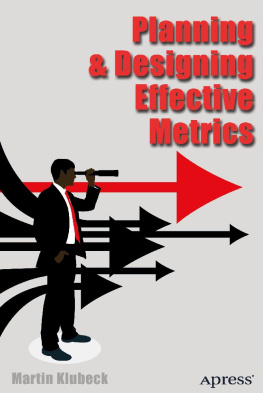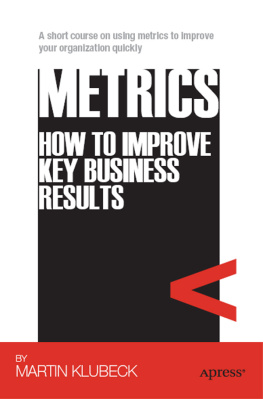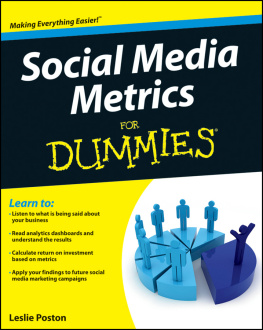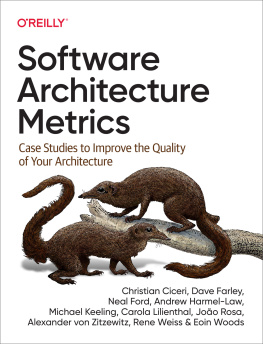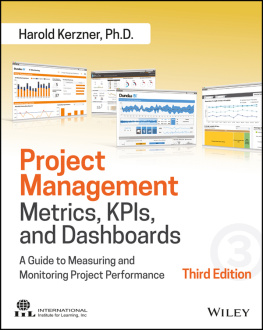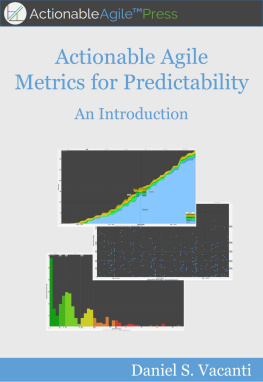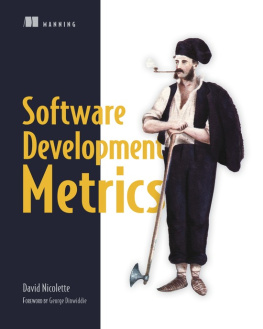Martin Klubeck - Planning and Designing Effective Metrics
Here you can read online Martin Klubeck - Planning and Designing Effective Metrics full text of the book (entire story) in english for free. Download pdf and epub, get meaning, cover and reviews about this ebook. year: 2014, publisher: Apress, genre: Children. Description of the work, (preface) as well as reviews are available. Best literature library LitArk.com created for fans of good reading and offers a wide selection of genres:
Romance novel
Science fiction
Adventure
Detective
Science
History
Home and family
Prose
Art
Politics
Computer
Non-fiction
Religion
Business
Children
Humor
Choose a favorite category and find really read worthwhile books. Enjoy immersion in the world of imagination, feel the emotions of the characters or learn something new for yourself, make an fascinating discovery.
- Book:Planning and Designing Effective Metrics
- Author:
- Publisher:Apress
- Genre:
- Year:2014
- Rating:4 / 5
- Favourites:Add to favourites
- Your mark:
Planning and Designing Effective Metrics: summary, description and annotation
We offer to read an annotation, description, summary or preface (depends on what the author of the book "Planning and Designing Effective Metrics" wrote himself). If you haven't found the necessary information about the book — write in the comments, we will try to find it.
Metrics are a hot topic. Executive leadership, boards of directors, management, and customers are all asking for data-based decisions. As a result, many managers, professionals, and change agents are asked to develop metrics, but have no clear idea of how to produce meaningful ones. Wouldnt it be great to have a fast, simple explanation of how to plan for and then design measurements to improve your organization?
Planning and Designing Effective Metricsan abridged version of author and metrics expert Martin Klubecks Metrics:How to Improve Key Business Resultsprovides that explanation and the tools youll need to make your organization more effective. Not only does this brief book explain the why of metrics, but it walks you through a step-by-step process to create a clear picture of organizational health and how well you satisfy customer needs.
This book:
- Provides a guide for planning and designing useful metrics based on your unique organizational needs
- Offers the theory behind metrics to help you get exponentially better practical results
- Shows how to select and use the proper tools for creating, implementing, and using metrics
- Provides examples of how to identify, collect, analyze, and report metrics that will be immediately useful for improving all aspects of the enterprise
Planning and Designing Effective Metrics will help you to measure the right things, the right waythe first time. No wasted effort, no chasing data. You will learn how to create valuable measures of organizational success, like repeat customers, customer loyalty, and word-of-mouth advertising. That will help you not only to improve organizational resultsyoull also multiply your career opportunities.
What youll learn- Understand the difference between data, measures, information, and metrics
- Identify root performance questions to ensure you build the right metrics
- Develop meaningful and accurate metrics
- Formulate practical answers to data-based questions
- Learn one of the most powerful methods yet invented for improving organizational results
Planning and Designing Effective Metrics was written for managers in the for-profit and nonprofit worlds who need to improve key results: department heads, middle managers, analysts, IT professionals, and change agents.
Table of Contents- Introduction: Who, What, Where, When, Why, and How You Use Metrics
- Establishing a Common Language
- Where to Begin: Planning a Good Metric
- Using Metrics as Indicators
- Triangulation: Essential to Creating Effective Metrics
- Establishing Standards and Benchmarks
- Appendix: Metrics Tools to Use and Useful Resources
Martin Klubeck: author's other books
Who wrote Planning and Designing Effective Metrics? Find out the surname, the name of the author of the book and a list of all author's works by series.

